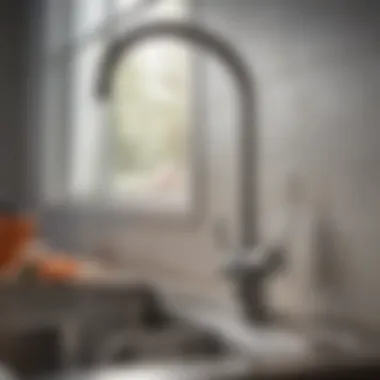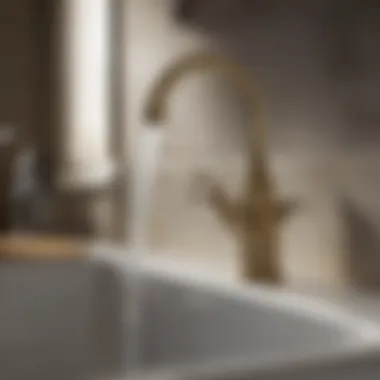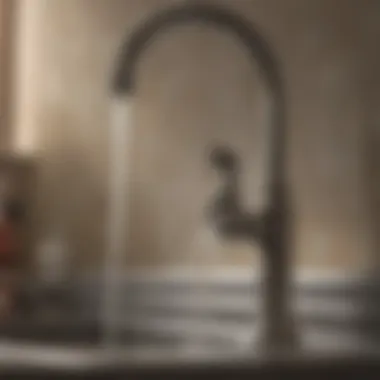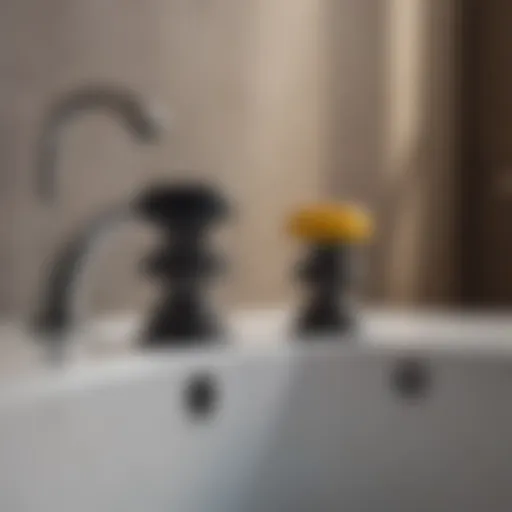Fixing Kitchen Sink Faucet Leaks: A Complete Guide


Intro
Kitchen sink faucet leaks can really set the mood off in your home. There’s nothing quite as annoying as the persistent drip-drip-drip sound when you're trying to enjoy a peaceful meal or unwind after a long day. Figuring out how to tackle such issues can seem like a Herculean task for many. Yet, understanding the basics can make this once-daunting task feel significantly more manageable.
Faucet leaks can spring from a variety of sources, from worn washers and seals to corroded components and faulty installation. The importance of addressing these leaks promptly cannot be overstated. Not only can untreated leaks lead to increased water bills, but they also cause water damage over time, fostering mold growth and potentially affecting the structural integrity of your home.
In this comprehensive guide, we'll arm you with the knowledge you need to identify the situational cause of those leaks, the tools necessary for repairs, and step-by-step instructions to remedy the problem yourself. This is about putting the power back in your hands so that, rather than feeling like a million bucks to fix a simple leak, you can roll up your sleeves and get the job done quickly and effectively.
Understanding Faucet Leaks
Faucet leaks may seem like a trivial concern, but they can lead to a cascade of issues if not addressed properly. Recognizing the ins and outs of faucet leaks is vital for household maintenance. Beyond the annoying drips that can disrupt the peace in a home, leaks can inflate water bills and cause water damage to cabinets and flooring over time. This article aims to equip you with the knowledge needed to tackle these problems head-on.
Identifying the Symptoms of a Leak
Spotting a faucet leak is the first step towards restoration. There are a few telltale signs that should raise a red flag:
- Dripping Water: The most obvious sign is water pooling under the sink or continuous dripping sounds.
- Decreased Water Pressure: If you notice a drop in water pressure, it can indicate that water is escaping through a faulty faucet.
- Water Marks: Look for stains or water rings on surfaces near the faucet; they signify that something isn't right.
- Higher Water Bills: A sudden spike in your water bill may indicate an unnoticed leak.
Recognizing these symptoms early can save homeowners not just money, but also a lot of hassle down the road.
Common Causes of Faucet Leaks
Faucet leaks rarely occur without reason. Understanding the common culprits can help not only in fixing leaks but also in ensuring they don't recur in the future. Let’s dive into some of the frequent offenders that lead to those nagging leaks.
Corroded Washers
Corroded washers play a primary role in creating leaks. As washers age, they can become brittle and wear down, leading to gaps that let water seep out. This is a key characteristic that contributes to leaks in older faucets, particularly those that are used frequently.
The unique feature of washers is their ability to create a tight seal, preventing water from escaping during use. However, when they corrode or degrade, that seal is compromised. The downside? Frequent replacement is necessary, which can be both time-consuming and tedious, especially in high-use areas like kitchens.
Faulty O-Rings
Faulty O-rings are another common suspect behind faucet leaks. These small rubber rings help seal connections, but age can lead to cracks or complete breakage. A characteristic feature is their flexibility when new; however, they tend to lose that over time.
O-rings are popular because they are easy to replace. If they fail, the result is often a steady drip or an ineffective faucet overall. Replacing them is usually the easiest part of addressing leaks, yet ignoring their maintenance can lead to larger issues over time.
Loose Connections
Loose connections might sound minor, but they can cause significant water loss if left unchecked. As faucets get used, components can loosen, creating gaps where water can escape. This simple factor has a major impact, contributing to water waste and potentially causing damage to fixtures under the sink.
The unique aspect of loose connections is that they often can be resolved without buying new parts. Tightening screws and bolts can usually restore a proper seal. However, if the connections aren't regularly checked, they can lead to more extensive issues over time.
Cracked Faucets
Lastly, cracked faucets themselves can be a source of leaks. A visible crack can often be spotted upon inspection, but sometimes, the damage can be hidden. The key characteristic here is the fragility of the material itself.
Cracked faucets may require full replacement rather than simple repairs. While they do offer immediate accessibility to water, the advantages dwindle quickly when they start leaking. Addressing the issue can save the hassle of more extensive damage later.
Understanding these causes of faucet leaks equips homeowners with the knowledge needed to recognize issues and take action. Whether it’s simply tightening a connection or replacing a washer, a little maintenance goes a long way.
Preparing for Repair
Before diving into the ins and outs of fixing a leaky faucet, it’s crucial to hit the pause button for a moment and get your ducks in a row. Preparing for repair isn’t just a step; it’s the bedrock of a successful fix. If you jump in haphazardly without a good plan, you could end up with more problems than you bargained for. This stage helps you assess what’s going on, gather the right tools, and ensure everything’s ready for a seamless repair.
Assessing the Leak's Severity
First things first, you need to gauge how serious the leak is. A small drip may seem trivial at first but can lead to bigger headaches down the line. Pinpointing the severity helps you decide if a DIY fix is your best bet or if you need to wave the white flag and call in a professional.
- Minor Leaks can usually be patched up with some new washers or O-rings, which translates to a straightforward afternoon of labor.
- Moderate Leaks might hint at deeper issues, such as loose connections or the faucet’s internal components needing attention.
- Major Leaks, on the other hand, could indicate a cracked faucet body or damaged plumbing that might have you reaching for your phone to schedule an appointment with your local plumber.


As you identify the leak's severity, take note of where the water is pooling and how often it drips. Documenting these issues aids in determining your next steps.
Gathering Necessary Tools
With the leak assessed, the next step is gathering the necessary tools. Think of this as your arsenal for the task ahead. Having the right tools on hand can save you time, and frustration, and ultimately make the repair process smooth. It’s always a wise move to gather these items before you start tinkering.
Wrench or Pliers
A wrench or pliers are non-negotiable when it comes to faucet repairs. These tools are essential for grasping and turning nuts and bolts that may be too tight for your hands to handle.
The key characteristic of either is their grip. Whether you opt for an adjustable wrench or a pair of pliers, their ability to hold onto components tightly is what makes them invaluable.
Despite some people favoring one over the other, they serve slightly different purposes – a wrench is more precise for specific fittings, while pliers are more versatile for various jobs. The unique feature of a wrench, like its adjustable size, allows you to customize the fit. On the flip side, pliers can easily handle awkward angles. Both tools are generally easy to find, making them a popular choice for repairs.
Screwdriver Set
Moving on to the next tool, a screwdriver set is also a must-have. Different faucets require different types of screws, and a well-rounded set has you covered.
The key characteristic of screwdrivers lies in their various head shapes – Phillips and flathead are staples. This allows you to tackle any screw type you encounter.
Having multiple sizes also plays a significant role; reaching into tight spaces is a common affair when working on faucets. While your typical multi-tool might get the job done, having dedicated screwdrivers is a beneficial choice because of their ergonomic designs that ease prolonged use. However, keep an eye on their sizing – choosing the wrong size can strip screw heads, complicating your efforts.
Replacement Washers and O-Rings
Replacement washers and O-rings deserve special mention. These small components are often the unsung heroes in stopping leaks. Think of them as the protectors of your faucet.
The key characteristic here is their ability to create a seal when properly fitted. They press against surfaces to stop water flow where it's not wanted. Quality materials matter here – rubber or silicone for durability as they resist wear and tear, making them a popular choice for homeowners tackling repairs.
While they might not seem like much, the unique feature of these parts is their crucial role in preventing leaks. Failing to replace worn washers or O-rings can lead to continued leaks, eating away at your efforts.
Plumber's Tape
Last but far from least, plumber's tape is a handy tool often overlooked. This tape serves a simple yet effective purpose – it aids in creating a watertight seal at threaded connections.
The key characteristic of plumber's tape is its flexibility. It can easily wrap around joints and prevent leaks when you reassemble components. This makes it a beneficial tool to keep on hand as it’s so simple to use even for those new to plumbing.
It’s noteworthy that using plumber's tape correctly can significantly enhance the overall quality of your repair by eliminating potential leak points. Just be cautious – too much tape can create complications, making it hard to tighten fittings properly.
By now, you should have a clear understanding of necessary tools and awareness of assessing the leak's severity. Each step you take in this preparation stage positions you for a successful repair, bringing you closer to a fully functional kitchen faucet.
Step-by-Step Repair Process
Understanding the step-by-step repair process is essential for successfully tackling a kitchen sink faucet leak. This systematic approach provides structure to what might otherwise be a chaotic and frustrating endeavor. By breaking down the repair into digestible steps, it not only boosts confidence but also minimizes the chances of overlooking crucial aspects. Each stage contributes to the overall goal of restoring functionality and preventing further leaks. The methodical unfolding of each task ensures clarity, making it easier for homeowners to execute the repairs effectively.
Shutting Off the Water Supply
Before diving in, it's vital to shut off the water supply. This prevents any accidental flooding, which can complicate an already intricate repair job. Commonly, the local stop valve located under the sink is the go-to for this. Simply twist it clockwise until it firmly closes. If there’s no valve present, turning off the home’s main water supply is necessary. This simple action is often overlooked by enthusiastic DIYers, but it lays the groundwork for a successful repair and keeps the workspace dry.
Disassembling the Faucet
Disassembling the faucet is the next logical step. This part can be tricky, but it’s necessary to get to the heart of the issue. Here are the components to consider:
Removing Handle
The act of removing the handle may seem trivial, but it holds great significance. This step allows access to the faucet’s internal mechanisms, making it easier to identify problems. The key characteristic of handle removal is the use of a screwdriver, which aligns well with the tools most homeowners have on hand. This method is widely recommended as it provides detailed access to what lies beneath the surface.
However, take caution: if you misplace screws during this process, reassembly will become a challenge. The handle itself is designed to fit snugly, ensuring no excess movement occurs. This snugness contributes to the overall functionality of the faucet, as loose handles can cause water to drip unexpectedly.
Detaching the Cartridge
Moving on to detaching the cartridge, this is where the main plumbing components come into play. Cartridges manage the flow and mix of hot and cold water, making this step crucial. The primary feature of this process lies in recognizing how the cartridge fits into the faucet assembly.


Typically, a counterclockwise twist will do the trick, but manufacturers have varied designs. Some might even require the use of a cartridge puller, making it beneficial for homeowners to be aware of their specific faucet type for seamless work. The unique aspect of this step is in its methodical approach; if you’re too quick or reckless, you risk damaging the housing, leading to costly replacements.
Inspecting Components
The final piece of disassembling is inspecting components. This step is about taking a close look at what’s been removed. Inspecting washers, O-rings, and the cartridge itself allows you to identify wear and tear that may be contributing to leaks. The key benefit here is catching subtle issues before they escalate into larger problems.
Several homeowners will overlook this step, thinking that as long as everything appears intact, they can proceed. However, the unique feature of thorough inspection is that it uncovers hidden flaws. Skipping it could lead to repeated leaks and unnecessary frustration later on.
Replacing Faulty Parts
Once disassembly and inspection are complete, it’s time to dive into replacing faulty parts. This phase ensures that all worn-out components are swapped for fresh ones, paving the way for a leak-free operating faucet.
Installing New Washers
When it comes to installing new washers, this simple yet critical task can often make a world of difference in the faucet’s performance. Washers are small but powerful in their ability to control the flow of water, and they can be responsible for leaks when worn. This step is beneficial because it is both cost-effective and relatively easy to do.
The unique feature of washers is their material; most are made of rubber or similar compounds, which wear out over time. By proactively replacing them during repairs, you mitigate the chances of encountering similar issues in the future, extending the lifespan of your faucet.
Fitting O-Rings Correctly
Next is fitting O-rings correctly. These seals are just as vital because they prevent water from mixing or escaping at the joints. It’s important to ensure that they are aligned properly and seated correctly in their grooves. This step is crucial; poorly fitted O-rings can lead to leaks just as easily as worn ones.
Their standard flexibility, when installed properly, creates a secure barrier, making them a popular choice for faucet repairs in this guide. Conversely, it can be a pain to deal with leaks arising from improper sealing, so double-checking is always wise.
Ensuring Seals are Tight
Lastly, ensuring seals are tight wraps up the replacement phase. After replacing parts, making sure every connection is snug is fundamental to the integrity of the faucet. This check enhances water flow and minimizes the risk of leaks reoccurring.
The unique aspect of this is that a secure seal has both functional and preventative benefits—it enables the faucet to serve well while hindering potential damages down the line.
Reassembling the Faucet
Once all replacements are in place, it’s time to tackle the reassembling of the faucet. Reassembly is often overlooked, but it plays a critical role in ensuring that all parts function together seamlessly.
Reattaching the Cartridge
First, focus on reattaching the cartridge. This step is quite significant for overall faucet performance. Ensuring it fits perfectly into its housing ensures that water flows smoothly. A vital aspect of this is that if disassembled improperly, it should not be forced back together. This might lead to more leaks and inefficiencies.
Getting it right within the assembly makes the entire process worthwhile. The cartridge design varies widely, so checking the manufacturer’s instructions here is a great way to avoid headaches down the road.
Testing the Handle Mechanism
Next comes testing the handle mechanism. This is where you ensure that everything moves freely. The handle must be responsive to adjustments without much effort, signaling that all connections and internal components are correctly aligned. This step can be considered a functional test to validate all prior efforts.
Proper handle movement indicates effective reassembly and prevent any further issues in the future. If something feels off or too loose, it's worth pausing to recheck alignment.
Securing All Screws
Finally, you must pay attention to securing all screws. This might seem like a no-brainer, yet it’s essential for maintaining the faucet’s structure. Loose screws can lead to leaks or even displace components over time. Tightening each screw ensures that parts stay in place and function properly, contributing to an overall solid assembly.
The characteristic nature of tightening screws throughout the process helps promote longevity while is also a simple yet vital task for a well-functioning faucet.
Restoring Water Supply
The last step in this comprehensive repair process is restoring the water supply. After confirming all parts are secured and operational, turn the valve counterclockwise gently to allow water flow back into the faucet. It’s wise to do this gradually—check for any immediate leaks as the water pressure is restored. This method ensures that you can catch any leaks early.
Testing the Repair
After you've completed the repair process of your kitchen sink faucet, it’s crucial to ensure everything is functioning as it should. Testing the repair is not merely a formality; it allows you to confirm that you've successfully addressed the leak and that there are no lingering issues that might quickly re-emerge. This phase is essential for your peace of mind, as it not only provides you a chance to identify any errors but also reinforces your confidence in your repair skills.
Checking for Leaks


The first step in testing is to check for leaks. This may sound straightforward, but there are nuances to it. After restoring the water supply, take a gentle look around the faucet and its components. Pay particular attention to the joints and connections where parts are fitted together. If you notice water droplets starting to form or trickling down, it may be a sign that a part is not properly sealed or needs replacing.
Here are a few pointers for effective leak-checking:
- Perform Visual Checks: Look for any signs of water pooling or dampness. A thorough inspection can reveal issues that might not be apparent right away.
- Feel for Moisture: Sometimes, a subtle leak won’t leave noticeable water behind but will make the area feel damp. Run your fingers along joints to feel for moisture.
- Use Paper Towels: Place a dry paper towel around the faucet base and let it sit for a few minutes. If any part of the towel gets wet, it indicates an issue.
"Even the smallest leak can lead to big problems down the road. Don’t ignore the signs."
Verifying Water Flow
Once you are satisfied that there are no leaks, the next logical step is to verify water flow. This aspect ensures that the faucet operates efficiently without obstruction. Turn on the faucet to check both hot and cold water settings. Make sure that the water flows smoothly and without any hiccups.
When assessing the water flow, keep these key points in mind:
- Observe the Flow Rate: A steady stream is what you should look for. If you notice sputtering or an irregular flow, it could indicate a problem. Try adjusting the handle to different settings to see if the flow changes.
- Listen for Unusual Sounds: Sometimes a properly functioning faucet will make subtle sounds. However, if you hear rattling or loud noises, this could signify air in the system or a blockage somewhere.
- Check Temperature: Ensure that both hot and cold settings deliver the expected temperatures promptly. A delay or lack of temperature change could indicate further issues in the plumbing system.
After performing these checks, you would be in a stronger position to assure yourself that the repair is indeed successful. If everything flows as smoothly as you hoped, then you’ve not only fixed your leak but have also fortified the functionality of your faucet. Such practices, when done consistently, contribute greatly to the longevity of your kitchen fixtures.
Preventative Maintenance
Maintaining your kitchen sink faucet goes beyond the occasional fix. Preventative maintenance is about ensuring longevity and efficiency in your plumbing system. By regularly taking proactive steps, you can sidestep the headache of costly repairs down the line. This practice becomes essential to safeguard your home against potential water damage and to keep your kitchen functioning smoothly.
Taking the time to properly maintain your faucet offers multiple benefits. First, it can significantly save you money that would otherwise go toward emergency repairs. Regular upkeep means you are less likely to experience sudden leaks or failures that could spell trouble and expensive fixes. Moreover, it contributes to a higher quality of life at home—no one enjoys dealing with drips or poor water flow when cooking or cleaning.
On top of that, quality maintenance extends the lifespan of your faucet. Like any other appliance, neglect could lead to erosion, rust, and wear and tear. By being vigilant, you can address small issues before they snowball into bigger problems. Keeping everything in good order helps preserve the overall aesthetic of your kitchen, too. A shiny, working faucet is far more pleasing to look at compared to one that’s been allowed to deteriorate.
Regular Inspection Practices
Regular inspections create a habit of checking in on the health of your faucet. Every few months, dedicate some time to assess for signs of wear. Look for drips or any changes in water pressure. If the faucet feels loose or wobbly, it's a clear sign that a closer look is needed.
- Here are some tips on how to inspect your faucet:
- Check for leaks: Open and close the faucet to see if water drips.
- Inspect seals and washers: These parts often wear out first.
- Evaluate water flow: If it seems restricted, it might indicate mineral buildup.
By keeping an eye out, you’ll often catch things early on and make adjustments before they escalate.
Importance of Quality Fixtures
Investing in quality fixtures cannot be overstated. When you install a high-quality faucet, you’re not only buying for the present but for the future as well. Cheaper alternatives may save you money upfront but usually end up costing more in repairs and replacements.
Quality fixtures are generally built to last. They withstand the test of time, resist corrosion, and often come with warranties, which can be a lifesaver down the line. Additionally, they tend to provide better performance—think smoother operation and more reliable water flow.
Ultimately, quality matters. It’s not just about having a functional faucet; it’s about having one that enhances your entire kitchen experience, adds value to your home, and minimizes long-term headaches. A well-chosen faucet is an investment in your home.
Remember: Keeping your kitchen faucet in check isn't merely a routine task; it’s a commitment to enhance your living space.
When to Seek Professional Help
Sometimes, despite our best efforts and a DIY ethic, faucet leaks can present challenges that go beyond our immediate expertise or resources. Knowing when to call in the cavalry can save not just time, but potentially a larger problem from brewing underneath your kitchen sink.
Signs That Indicate Complex Issues
Recognizing the signs of more serious plumbing problems is essential. Here are a few indicators that your faucet issue might require professional assessment:
- Consistent Low Water Pressure: If the water flow from your faucet is notably reduced, it may suggest a bigger issue within the plumbing system, beyond just the faucet.
- Color Changes in Water: If the water appears rusty or has an unusual color, it could mean corrosion or sediment buildup, hinting at issues in the pipes connected to your faucet.
- Expanding Moisture Areas: Puddles or water stains on the cabinetry surrounding the sink can signal leakage that may have spread beyond the faucet itself, which often requires a keen eye and expertise to trace.
- Foul Smells: Any odors emanating from the faucet or surrounding area could indicate mold or sewage problems that warrant immediate action.
- Recurrent Plumbing Problems: If you've found yourself repeatedly fixing similar issues, it might be worth consulting a professional to diagnose and fix the underlying cause.
Identifying such signs not only ensures the integrity of your plumbing system but can also prevent potentially costly damages down the line.
Cost Considerations
When contemplating whether to call a plumber, cost naturally comes into play. While DIY repairs carry no charge beyond your time, professional services come with their own expenses. Consider the following:
- Service Fees: Most plumbing services charge a trip fee that covers the technician’s travel time, often in addition to billing for the actual repair work. This fee can range significantly based on location and company.
- Parts and Labor: Common repairs may not seem costly at first glance, but when factoring in both parts—like specialized faucet components—and labor, expenses can mount quickly.
- Potential for Additional Damage: If a simple leak evolves into a bigger repair issue, the costs can escalate. Hiring a professional early may actually save money in the long run by avoiding more extensive repairs.
- Long-term Value: Investing in professional help might also yield higher quality repairs that could prolong the life of your faucet compared to a temporary DIY fix.
Before diving into repairs, weighing the financial implications can give you a clearer picture and help to navigate the depth of the problem effectively.
Always remember, sometimes it's worth it to invest in your home by bringing in a pro—better safe than soggy!







